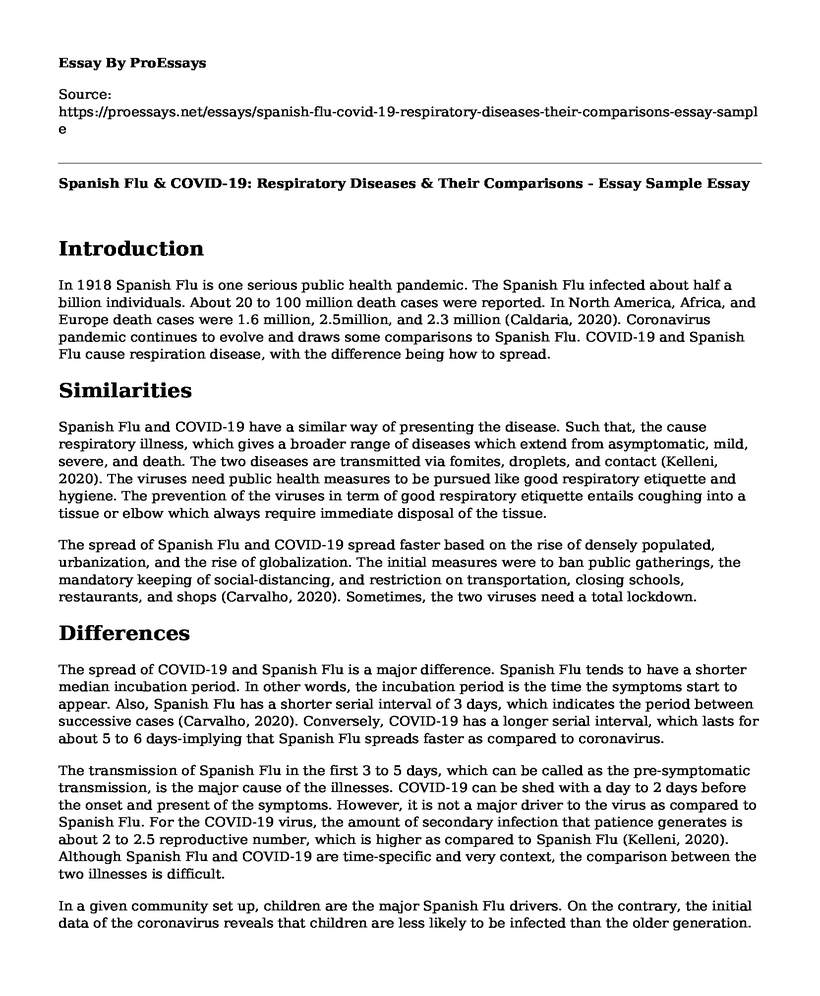Introduction
In 1918 Spanish Flu is one serious public health pandemic. The Spanish Flu infected about half a billion individuals. About 20 to 100 million death cases were reported. In North America, Africa, and Europe death cases were 1.6 million, 2.5million, and 2.3 million (Caldaria, 2020). Coronavirus pandemic continues to evolve and draws some comparisons to Spanish Flu. COVID-19 and Spanish Flu cause respiration disease, with the difference being how to spread.
Similarities
Spanish Flu and COVID-19 have a similar way of presenting the disease. Such that, the cause respiratory illness, which gives a broader range of diseases which extend from asymptomatic, mild, severe, and death. The two diseases are transmitted via fomites, droplets, and contact (Kelleni, 2020). The viruses need public health measures to be pursued like good respiratory etiquette and hygiene. The prevention of the viruses in term of good respiratory etiquette entails coughing into a tissue or elbow which always require immediate disposal of the tissue.
The spread of Spanish Flu and COVID-19 spread faster based on the rise of densely populated, urbanization, and the rise of globalization. The initial measures were to ban public gatherings, the mandatory keeping of social-distancing, and restriction on transportation, closing schools, restaurants, and shops (Carvalho, 2020). Sometimes, the two viruses need a total lockdown.
Differences
The spread of COVID-19 and Spanish Flu is a major difference. Spanish Flu tends to have a shorter median incubation period. In other words, the incubation period is the time the symptoms start to appear. Also, Spanish Flu has a shorter serial interval of 3 days, which indicates the period between successive cases (Carvalho, 2020). Conversely, COVID-19 has a longer serial interval, which lasts for about 5 to 6 days-implying that Spanish Flu spreads faster as compared to coronavirus.
The transmission of Spanish Flu in the first 3 to 5 days, which can be called as the pre-symptomatic transmission, is the major cause of the illnesses. COVID-19 can be shed with a day to 2 days before the onset and present of the symptoms. However, it is not a major driver to the virus as compared to Spanish Flu. For the COVID-19 virus, the amount of secondary infection that patience generates is about 2 to 2.5 reproductive number, which is higher as compared to Spanish Flu (Kelleni, 2020). Although Spanish Flu and COVID-19 are time-specific and very context, the comparison between the two illnesses is difficult.
In a given community set up, children are the major Spanish Flu drivers. On the contrary, the initial data of the coronavirus reveals that children are less likely to be infected than the older generation. In essence, the clinical attack of COVID-19 has a low rate of between 0 and 19 age groups (Carvalho, 2020). The other preliminary data based on household transmission suggested that in China, the children were infected from adults with the reverse being falsified.
Although the Spanish Flu and COVID-19 have similar symptoms, the severity of the viruses differs. Research reveals that about 80 percent of COVID-19 infections are asymptomatic or mild, five percent are deemed as critical infections that need ventilation, and 15 percent are severe, but needs oxygen (Caldaria, 2020). Thus, the fractions of critical and severe infections are higher as compared to Spanish infection. For coronavirus, the older population and conditions increase severe infection risk. Conversely, those who are at higher risk of contracting Spanish Flu are the elderly, women, and children, those with other chronic disorders, and immunosuppressed patients. During Spanish Flu Pandemic, healthy people were advised to avoid direct contact from patients by taking prophylactic remedies like oral quinine, potassium permanganate, gargling, drinking wine, and eating cinnamon (Caldaria, 2020). For COVID-19, a healthy population is advised to hand-wash using sanitizer and cover their faces while working to avoid the spread of the virus.
Spanish Flu has a lower mortality rate that COVID-19. However, still, it is yet to establish the true mortality rate of COVID-19. Even so, the current data display that the crude mortality ratio ranges between 3 and 4 percent (Kelleni, 2020). Based on the reported case, reports suggest that the infection mortality rate will be lower. For Spanish Flu, the mortality rate can be determined by access to quality health care. COVID-19 still does not have any vaccine, whereas the Spanish Flu' vaccine is available. Research supports that people should be vaccinated from Spanish Flu to avoid the spread of the pandemic (Carvalho, 2020). The vaccine was effective in slowdown the spread of Spanish Flu.
Conclusion
In conclusion, COVID-19 and Spanish Flu cause respiration disease, with the difference being how the viruses spread. As they cause respiratory illnesses, the two viruses give a broader range of diseases, which extend from asymptomatic, mild, severe, and death. COVID-19 and Spanish Flu are transmitted via fomites, droplets, and contact. Although the Spanish Flu and COVID-19 have similar symptoms, the severity of the viruses differs. Spanish Flu has a shorter serial interval of 3 days, which indicates the period between successive cases. Conversely, COVID-19 has a longer serial interval, which lasts for about 5 to 6 days.
References
Caldaria, A., Conforti, C., Di Meo, N., Dianzani, C., Jafferany, M., Lotti, T., Zalaudek, I., & Giuffrida, R. (2020). COVID 19 and SARS: Differences and similarities. Dermatologic Therapy. https://doi.org/10.1111/dth.13395
Carvalho, T. (2020). undefined. Nature Medicine. https://doi.org/10.1038/d41591-020-00006-0
Kelleni, M. (2020). undefined. https://doi.org/10.20944/preprints202004.0432.v1
Cite this page
Spanish Flu & COVID-19: Respiratory Diseases & Their Comparisons - Essay Sample. (2023, Jul 05). Retrieved from https://proessays.net/essays/spanish-flu-covid-19-respiratory-diseases-their-comparisons-essay-sample
If you are the original author of this essay and no longer wish to have it published on the ProEssays website, please click below to request its removal:
- Lymphedema Treatment Research Paper
- Codeine and Human Genetics
- Emergency Management Doctrine
- The Role of End Users in Incident Reporting Essay Example
- Hand Hygiene Essential for Patient Care: Essay Sample
- Essay Example on NGO Resources: How Boards Manage for Needy Groups
- Essay Example on My Professional Journey: A Nurse's Ambition to Grow and Succeed







